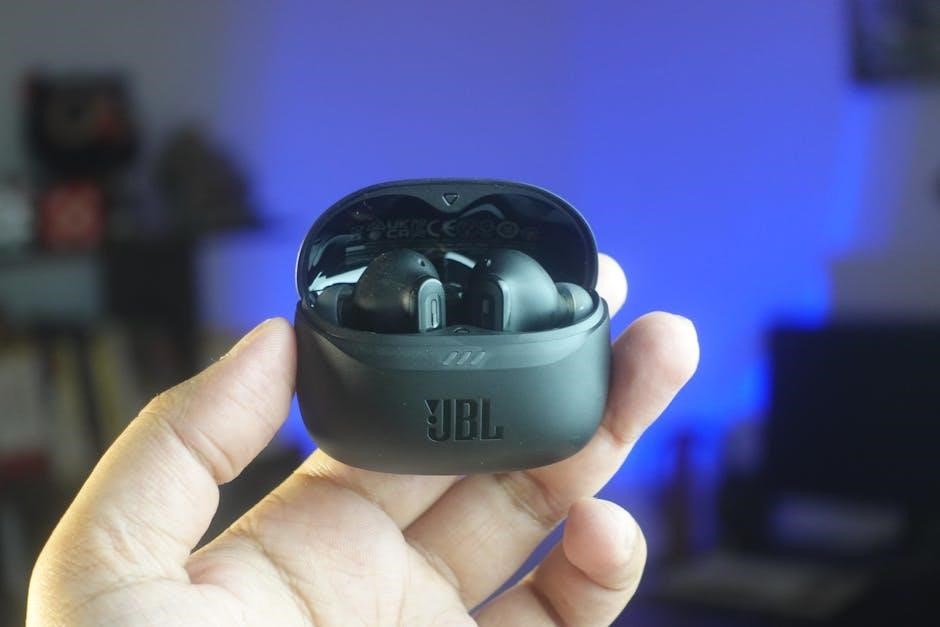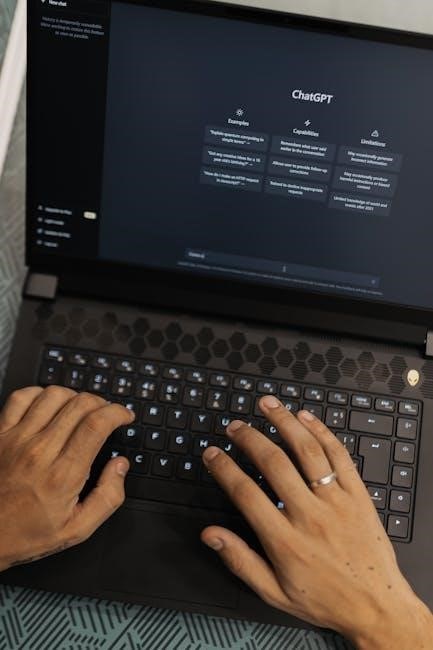Quick Start Guide
Unpack your JBL Charge 3, ensuring all accessories like the micro-USB cable and AUX input are included. Charge the speaker using the provided cable until the battery indicator shows full charge. Turn it on and pair your device via Bluetooth to start enjoying your music.
What’s in the Box
Inside the JBL Charge 3 box, you’ll find the speaker itself, a micro-USB charging cable, a quick start guide, and warranty information. The speaker is wrapped in protective packaging to ensure safe delivery. Additionally, some versions may include an AUX input cable for wired connections. The box is designed to provide everything you need to get started, with clear instructions in the quick start guide to help you set up and use your speaker immediately. No extra accessories like chargers or cases are included, but the essentials are covered. The packaging is compact and organized, making it easy to unpack and begin enjoying your music right away.
Understanding the Buttons and Controls
The JBL Charge 3 features a user-friendly control panel located on the top of the speaker. The buttons are clearly labeled and provide easy access to essential functions. The power button, marked with a circle, turns the speaker on and off. Next to it is the Bluetooth button, which is used to initiate pairing mode and connect to your device. The volume controls consist of plus and minus buttons, allowing you to adjust the sound to your liking. In the center, you’ll find the play/pause button, which also serves as a multifunction button for skipping tracks or answering calls when connected to a smartphone. Additionally, the JBL Connect button enables you to link multiple JBL speakers for amplified sound. The LED indicator near the power button shows the speaker’s status, such as charging, pairing, or low battery. These buttons are designed for intuitive use, making it easy to navigate and customize your listening experience without confusion.
Connecting the Speaker for the First Time
First, ensure the JBL Charge 3 is fully charged before initial use. Turn the speaker on by pressing the power button until the LED indicator lights up. Open your device’s Bluetooth settings and locate the JBL Charge 3 in the available devices list. Select it to begin pairing. You’ll know the connection is successful when the speaker emits a confirmation tone and the LED flashes blue. If pairing doesn’t occur automatically, press the Bluetooth button on the speaker to manually enter pairing mode. Once connected, you can stream music, podcasts, or any audio from your device. For non-Bluetooth devices, use the AUX input by connecting the speaker with a 3.5mm audio cable. Ensure the speaker is turned on and set to AUX mode for proper functionality. Remember, the JBL Charge 3 is IPX7 waterproof, but keep all ports sealed during use to maintain water resistance. Enjoy your seamless listening experience with crystal-clear sound and deep bass.

Design and Build Quality
The JBL Charge 3 features a durable, waterproof design with IPX7 certification, ensuring protection against accidental splashes or submersion. Its cylindrical shape and rubberized finish provide a premium feel, while the exposed passive radiators add a touch of modern style. Built to last, it withstands rough handling and outdoor use effortlessly.
Water Resistance and IPX7 Rating
The JBL Charge 3 boasts an IPX7 rating, making it fully waterproof and capable of withstanding submersion in water up to 1 meter for 30 minutes. This feature ensures the speaker remains functional even after accidental exposure to water, such as rain or poolside splashes. To maintain its water resistance, it’s crucial to remove all cable connections and tightly close the cap before exposing the speaker to liquids. Additionally, the speaker should not be submerged while charging, as this could cause permanent damage to the device or its power source. Proper care and adherence to these guidelines will ensure the longevity of your JBL Charge 3, allowing you to enjoy uninterrupted music in various outdoor settings without worrying about water damage.
Battery Life and Playtime
The JBL Charge 3 offers an impressive battery life, providing up to 20 hours of continuous playtime on a single charge. This makes it an ideal companion for extended outdoor gatherings, camping trips, or long days at the beach. The battery is powered by a 6000mAh lithium-ion cell, which ensures reliable performance throughout the day; When the battery level is low, the speaker indicates this with a flashing red light, reminding you to recharge it. Recharging is done via the micro-USB port, and it typically takes around 4-5 hours to reach full capacity. Additionally, the JBL Charge 3 can double as a power bank, allowing you to charge your smartphone or other devices on the go by connecting them to the speaker’s USB port. This feature adds convenience, especially when you’re away from power outlets. Overall, the combination of long playtime and the ability to charge other devices makes the JBL Charge 3 a versatile and practical choice for music lovers who value durability and performance.
Speaker Drivers and Sound Quality
The JBL Charge 3 is equipped with two 1.8-inch drivers and a separate subwoofer, delivering robust and balanced audio across various genres of music. The speaker excels in producing clear mid-range frequencies, ensuring vocals and instruments sound crisp and distinct. High frequencies are also handled well, with minimal distortion even at higher volumes. The bass performance is particularly noteworthy, offering deep and punchy lows that add depth to the overall soundstage. However, some users have noted that the Charge 3 slightly sacrifices sound quality compared to its predecessor, the Charge 2+, in favor of improved water resistance and battery life. Despite this, the speaker remains a strong contender for outdoor and casual listening, providing a well-rounded audio experience that caters to a wide range of musical preferences. The JBL Charge 3 strikes a balance between portability, durability, and sound quality, making it a versatile choice for everyday use;

Connecting the JBL Charge 3
The JBL Charge 3 supports Bluetooth pairing, AUX input, and JBL Connect for multi-speaker setups. Enable Bluetooth on your device, locate the speaker, and pair. For wired connections, use the AUX port. JBL Connect allows syncing with other compatible speakers for amplified sound.
Bluetooth Pairing Process
To pair your JBL Charge 3 via Bluetooth, start by turning on the speaker. The power button is located on the top, and the speaker will emit a start-up sound. Next, enable Bluetooth on your device, such as a smartphone or tablet, and ensure it is discoverable. Open your device’s Bluetooth settings and search for available devices. The JBL Charge 3 will appear in the list as “JBL Charge 3.” Select it to initiate pairing. You may hear a confirmation tone once connected. If prompted, confirm the pairing on both the speaker and your device. The Bluetooth LED indicator on the speaker will flash blue during pairing and turn solid blue once connected. If pairing fails, reset the speaker by pressing and holding the Bluetooth button until the LED flashes blue, then try again. Once paired, the JBL Charge 3 will automatically reconnect to your device in the future. For troubleshooting, ensure the speaker is fully charged and within range of your device;
Tip: If pairing issues persist, restart both the speaker and your device before attempting again.
Using the AUX Input
To use the AUX input on your JBL Charge 3, locate the 3.5mm auxiliary port on the speaker, typically found under the waterproof cap. Insert one end of a 3.5mm audio cable into this port and connect the other end to the headphone jack of your device, such as a smartphone, tablet, or MP3 player. Once connected, turn on the speaker and ensure it is in AUX mode. You can switch modes by pressing the “Source” or “Input” button until the AUX mode is selected. The speaker will emit a tone to confirm the mode change. Adjust the volume using either the speaker’s controls or your connected device. For optimal sound quality, ensure the AUX cable is securely connected to both devices. If no sound is heard, check the cable for damage or try a different one. The JBL Charge 3 will prioritize the AUX input over Bluetooth once connected, so you can enjoy wired audio without interruption. This feature is ideal for devices without Bluetooth capabilities or for situations where a wired connection is preferred.
Tip: Keep the AUX port clean and dry to avoid any connection issues and maintain sound quality.
Connecting Multiple Speakers with JBL Connect
To connect multiple JBL Charge 3 speakers using the JBL Connect feature, press the JBL Connect button on each speaker. This button is usually located on the top or side of the speaker and is marked with the JBL Connect logo. Once pressed, the speakers will automatically start pairing with one another. You will hear a tone or see an LED indicator to confirm the connection. Ensure all speakers are turned on and in range of each other for the connection to work properly. Once connected, all speakers will play the same audio from your paired device. This feature is ideal for creating a immersive sound experience in large spaces or outdoor gatherings. For troubleshooting, restart the speakers or ensure they are updated to the latest firmware. The JBL Connect feature allows for seamless audio synchronization, enhancing your listening experience with louder and more expansive sound. Follow the quick start guide for detailed steps, but remember to keep your speakers close during the pairing process for the best results.

Sound Quality and Performance
The JBL Charge 3 delivers balanced sound with deep bass and clear highs, powered by dual 1.97-inch drivers and a 10W subwoofer. It supports Bluetooth 4.1 for stable wireless connectivity. The speaker offers 20 hours of playtime and is IPX7 waterproof for outdoor use.
Audio Output and Frequency Response
The JBL Charge 3 delivers a powerful audio output with a frequency response of 45Hz to 20kHz, ensuring rich bass and clear highs. Equipped with two 1.97-inch drivers and a 10W subwoofer, it provides balanced sound across all genres. The speaker’s dual passive radiators enhance bass performance, making it suitable for both indoor and outdoor use. With a maximum power output of 20W, it fills spaces with immersive sound. The Bluetooth 4.1 technology ensures stable wireless connectivity, allowing seamless music streaming from compatible devices. Additionally, the speaker supports auxiliary input for wired connections. Its IPX7 waterproof design makes it durable and ideal for poolside or beach gatherings. The JBL Charge 3’s audio capabilities are further complemented by its long-lasting battery life of up to 20 hours, ensuring uninterrupted entertainment. Whether you’re streaming your favorite playlists or hosting a party, this speaker delivers consistent and high-quality audio performance.
Bass and Treble Performance
The JBL Charge 3 excels in delivering robust bass and crisp treble, making it a versatile speaker for various music genres. Its dual 1.97-inch drivers and passive radiators work together to produce deep, resonant bass that enhances low-frequency sounds without distortion. The treble is clear and well-defined, ensuring that high notes remain sharp and detailed. This balance allows the speaker to handle genres like hip-hop, rock, and electronic music with ease. The midrange is also smooth, providing a natural soundstage that complements both vocals and instruments. While the bass is prominent, it doesn’t overpower the treble, creating a balanced audio experience. The speaker’s ability to maintain sound clarity at higher volumes further highlights its performance capabilities. Whether you’re enjoying bass-heavy tracks or acoustic melodies, the JBL Charge 3 delivers a satisfying listening experience. Its audio tuning makes it suitable for both indoor and outdoor settings, ensuring consistent sound quality in any environment.
Volume Levels and Sound Distortion
The JBL Charge 3 offers impressive volume levels, capable of filling large spaces with clear and powerful sound. It maintains sound clarity even at maximum volume, with minimal distortion. The speaker’s advanced driver design ensures that high volumes do not compromise audio quality, providing a consistent listening experience. However, at extreme volumes, slight distortion may occur, particularly in bass-heavy tracks. This is manageable and does not significantly detract from the overall performance. The speaker’s ability to handle a wide range of volume levels makes it suitable for both quiet gatherings and lively parties. Users can adjust the volume seamlessly using the buttons on the speaker or through their connected device. The JBL Charge 3 strikes a balance between loudness and sound integrity, delivering a robust audio output that meets the demands of various settings. Its performance remains reliable, whether you prefer soft background music or energetic playlists.

Battery and Charging
The JBL Charge 3 features a built-in 6000mAh battery, offering up to 20 hours of continuous playtime. It charges via a micro-USB cable, with a full charge taking approximately 4.5 hours. The speaker also doubles as a power bank, allowing you to charge other devices on the go. The battery level is indicated by a series of LED lights, providing clear feedback on remaining power. To ensure optimal performance, avoid overcharging and keep the speaker away from extreme temperatures during charging. The speaker automatically turns off after 20 minutes of inactivity to conserve battery life.
Charging the Battery
To charge the JBL Charge 3, locate the micro-USB port on the rear of the speaker and insert the provided micro-USB cable. Plug the other end into a compatible USB power source, such as a wall adapter or computer. The speaker features a 6000mAh battery, and charging typically takes about 4.5 hours for a full charge. During charging, the LED indicator on the front will display a red light. Once fully charged, the LED will turn off. Avoid overcharging to maintain battery health. If the battery level is low, the LED will flash red. For optimal performance, charge the speaker in a cool, dry environment. The JBL Charge 3 also functions as a power bank, allowing you to charge other devices via the USB port. Ensure the speaker is turned off while charging to prioritize battery replenishment. Always use the original cable and adapter for safe and efficient charging. If issues arise, reset the speaker by pressing and holding the power button for 10 seconds before attempting to charge again.
The JBL Charge 3 offers an impressive battery life of up to 20 hours of continuous playtime on a single charge, making it ideal for extended outdoor activities or events. The 6000mAh lithium-ion battery ensures consistent performance throughout the day. Actual playtime may vary depending on volume levels and usage patterns. At moderate volumes, the speaker can easily last a full day. When the battery is low, the LED indicator flashes red, signaling it’s time to recharge. To conserve battery life, turn the speaker off when not in use or lower the volume during extended periods of playback. The speaker also supports quick charging, providing several hours of playtime with just a short charge. Additionally, the JBL Charge 3 can function as a power bank, allowing you to charge your smartphone or other devices on the go. This feature is particularly useful for keeping your devices powered up during long trips or festivals. Ensure the speaker is fully charged before extended use for the best experience. Regularly updating the firmware can also optimize battery performance.
Charging Other Devices via USB
The JBL Charge 3 features a built-in USB port, allowing you to charge your smartphone, tablet, or other USB-enabled devices on the go. This convenient power bank functionality is especially useful during outdoor adventures or when access to a power outlet is limited. To charge another device, locate the USB port on the rear of the speaker and connect your device using a standard USB cable. Ensure the speaker is turned on, as the USB port only functions when the device is active. The 6000mAh battery provides ample power to recharge most smartphones multiple times. However, charging other devices will reduce the speaker’s playtime, so use this feature wisely. For safety, avoid overcharging your devices, and always use the original cable and adapter to prevent damage. The USB port supports standard charging speeds, making it a reliable backup power source. This feature enhances the speaker’s versatility, making it a great companion for travel and outdoor activities. Regularly updating the speaker’s firmware can also improve charging efficiency and overall performance.
JBL Connect Feature
JBL Connect™ is a wireless technology that allows you to link multiple JBL speakers for synchronized music playback. This feature enhances sound quality and creates an immersive audio experience, perfect for parties or large spaces. Use it to pair up to 100 JBL Connect-enabled speakers.
What is JBL Connect?
JBL Connect is a cutting-edge wireless technology designed to enhance your audio experience. It allows seamless connection of multiple JBL speakers, enabling synchronized music playback across all linked devices. This feature is particularly useful for creating an immersive sound environment at gatherings or in large spaces. JBL Connect ensures that all connected speakers play the same music simultaneously, providing a cohesive and amplified listening experience.
One of the standout features of JBL Connect is its ability to link up to 100 compatible JBL speakers. This scalability makes it ideal for both personal use and large-scale events. The technology operates on a proprietary wireless protocol, ensuring stable and high-quality audio transmission between devices. Additionally, JBL Connect is user-friendly, with a straightforward pairing process that requires minimal setup.
By utilizing JBL Connect, users can enjoy a more dynamic and engaging sound experience. It transforms individual speakers into a unified system, delivering richer and more immersive audio. This feature is a testament to JBL’s commitment to innovation and enhancing the way people enjoy music.
How to Connect Multiple Speakers
Connecting multiple JBL Charge 3 speakers is a straightforward process using the JBL Connect feature. Start by ensuring all speakers are turned on and in close proximity to each other. Locate the JBL Connect button, typically found on the speaker’s control panel, and press it on each speaker you wish to connect. The button will illuminate, indicating that the pairing process has begun.
Once the first speaker is activated, the others will automatically detect and connect to it. You will hear a confirmation sound once the connection is successful. Repeat this process for all additional speakers you want to link. The system allows up to 100 JBL Connect-enabled speakers to be connected simultaneously, creating a powerful and immersive audio experience.
Ensure all speakers are within range of each other for a stable connection. Once connected, they will play the same music in sync, providing a cohesive listening experience. This feature is perfect for parties, outdoor gatherings, or filling large spaces with sound. The JBL Connect technology ensures a seamless and user-friendly way to expand your audio setup.
Troubleshooting JBL Connect Issues
If you encounter issues while connecting multiple JBL Charge 3 speakers via JBL Connect, start by ensuring all speakers are powered on and in close proximity to each other. Check that each speaker has the latest firmware installed, as outdated software can hinder connectivity.
Next, verify that the JBL Connect button is functioning properly on all devices. Press and hold the button for a few seconds to activate pairing mode. If the connection fails, restart all speakers and attempt the process again. Ensure there are no physical obstructions between the speakers that could interfere with the wireless signal.
If issues persist, reset the speakers by pressing and holding the volume up and down buttons simultaneously for 10 seconds. This will restore the speaker to its factory settings. After resetting, try reconnecting the speakers. Additionally, consult the JBL Charge 3 user manual or contact JBL support for further assistance if the problem remains unresolved.

